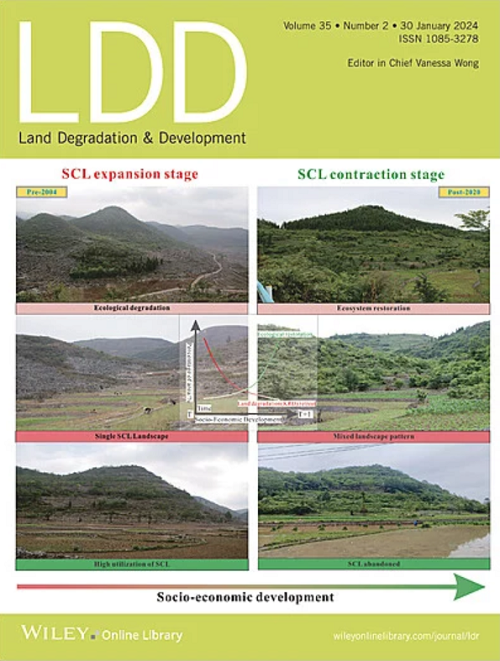喀斯特天坑是退化喀斯特景观中微生物多样性的避难所
IF 3.6
2区 农林科学
Q2 ENVIRONMENTAL SCIENCES
引用次数: 0
摘要
喀斯特天坑被称为地球表面最大的负地形,被垂直的悬崖隔离,并在其中保持着独特的生态系统。然而,对岩溶天坑微生物生态学的认识与其重要性并不相称。为此,我们在16个喀斯特天坑和2个地点进行了广泛的采样,并使用高通量测序方法对土壤细菌和真菌进行了分析。本研究发现喀斯特天坑微生物群落丰富多样,以变形菌门、酸菌门(细菌)和子囊菌门、担子菌门(真菌)为主要门。与退化的喀斯特景观相比,喀斯特天坑保持了较高的细菌类群丰富度。喀斯特天坑常见和特有的微生物类群遵循着共同营养和机会主义的策略,这些类群与高土壤养分(TN和SOM)和含水量有关。喀斯特天坑通过合作维持了稳定的微生物网络结构,细菌和真菌群落的聚集主要受分散限制的支配。研究结果增强了对地下喀斯特生态系统微生物组的认识,强调了喀斯特天坑是退化喀斯特景观中微生物多样性的重要避难所。本文章由计算机程序翻译,如有差异,请以英文原文为准。
Karst Tiankeng Is the Refuge of Microbial Diversity in the Degraded Karst Landscape
Known as the largest negative terrain on the earth's surface, the karst tiankeng is isolated by vertical cliffs and maintains a unique ecosystem within it. However, knowledge of the microbial ecology of karst tiankengs does not match their importance. To this end, we conducted extensive sampling across 16 karst tiankengs and 2 sites and used high-throughput sequencing methods to analyze soil bacteria and fungi. This study found abundant and diversified microbial communities in karst tiankengs, with Proteobacteria, Acidobacteriota (Bacteria), and Ascomycota, Basidiomycota (Fungi) being the main phyla. Compared to the degraded karst landscape, karst tiankengs maintained a higher richness of bacterial taxa. The common and exclusively microbial taxa in karst tiankengs follow copiotrophic and opportunistic strategies, and these taxa are associated with high soil nutrients (TN and SOM) and water content. Karst tiankeng maintained a stable microbial network structure through cooperation, and the dispersal limitation dominated the bacterial and fungal community assembly. Our results enhance the understanding of microbiomes in subterranean karst ecosystems, highlighting that karst tiankengs are important refuges for microbial diversity in degraded karst landscapes.
求助全文
通过发布文献求助,成功后即可免费获取论文全文。
去求助
来源期刊

Land Degradation & Development
农林科学-环境科学
CiteScore
7.70
自引率
8.50%
发文量
379
审稿时长
5.5 months
期刊介绍:
Land Degradation & Development is an international journal which seeks to promote rational study of the recognition, monitoring, control and rehabilitation of degradation in terrestrial environments. The journal focuses on:
- what land degradation is;
- what causes land degradation;
- the impacts of land degradation
- the scale of land degradation;
- the history, current status or future trends of land degradation;
- avoidance, mitigation and control of land degradation;
- remedial actions to rehabilitate or restore degraded land;
- sustainable land management.
 求助内容:
求助内容: 应助结果提醒方式:
应助结果提醒方式:


